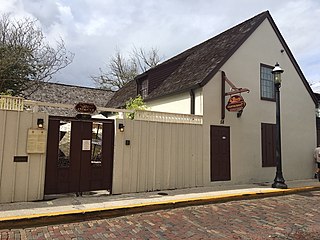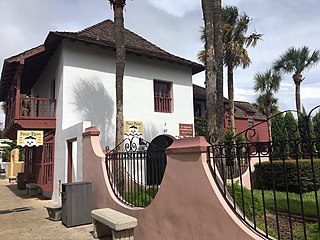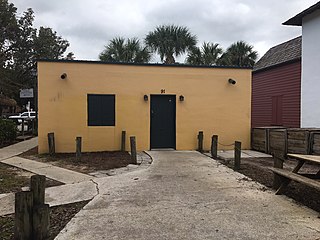
The Ortega House is located at 70 St. George Street in St. Augustine, Florida. It is a reconstructed home representing the architectural style of the First Spanish Period (1565-1763) in Florida.

The Ortega House is located at 70 St. George Street in St. Augustine, Florida. It is a reconstructed home representing the architectural style of the First Spanish Period (1565-1763) in Florida.
A house first appears at this site on a Spanish map dating to 1763. A map from one year later tells us that the inhabitants were descendants of one Nicolas de Ortega, who was listed as an armorer at the Castillo de San Marcos. De Ortega died in 1762. It is expected that when Spain ceded Florida to Great Britain with the 1763 Treaty of Paris, British agent Jesse Fish took over temporary ownership of the property. The British governor granted the property in November 1779 to a John Proctor. After Proctor's death the house was sold in June 1787, at public sale, for 250 pounds to James Scotland, carpenter. When Spain again changed hands in 1783, Scotland left Florida and gave his house to William Slater to sell. [1] The British Period saw a kitchen and loggia added to the house. [2]
Minorcan Sebastian Ortega purchased the house in 1791 and made significant changes to it. He put on a new roof, replastered walls, and put in a tabby floor. After passing through the hands of other families, Miguel Andreu bought the home in 1815, which was then in poor condition. The Andreu family held this property until the 1830s. [1]
In 1967, the St. Augustine Historical Restoration and Preservation Commission decided to spend $60,000 to purchase the Edmunds-Rogers property, which encompassed the site of the present day Ortega House. [3] After the reconstruction project was completed, the Ortega House was leased as a private residence. Mr. and Mrs. George Waldron lived in the house beginning September 1, 1968. Other residential spaces for rent in the restored area were a building in back of the Spanish Inn, one apartment on the second floor of the Salcedo House, two apartments in the Watson House, and one apartment on the second floor of the Benet Store. [2]
Today, the Ortega House is owned by the St. Augustine Foundation, Inc. It is a retail space operated by The Hyppo Gourmet Ice Pops. [4]

The Llambias House is a historic house located at 31 Saint Francis Street in St. Augustine, Florida. Built sometime before 1763, it is one of the few houses in Florida to survive from the first period of Spanish Florida. It was designated a National Historic Landmark on April 15, 1970. The house is now managed by the St. Augustine Historical Society as an event venue.

The Spanish Military Hospital Museum is located at 3 Aviles Street, St. Augustine, Florida. The museum covers the Second Spanish Period (1784-1821) medical practices. The museum is open seven days a week from 9am to 5pm. Tours start on demand throughout the day and cover a surgical demonstration, apothecary demonstration, and tours of a medicinal herb garden.

Government House, also known as Governor's House, is located at 48 King Street in St. Augustine, Florida, adjacent to the Plaza de la Constitución. The building, constructed of coquina, served as the governor's official residence from c. 1710 during the First Spanish Period (1565–1763), throughout the British Period (1763–1784), and until 1812 in the Second Spanish Period (1784–1821). Governor Gonzalo Méndez de Canzo was the first governor to build his residence on the present Government House site in 1598.

The Oliveros House is located at 59 St. George Street, St. Augustine, Florida. It was built of coquina during the Second Spanish Period in Florida (1565-1763). Today it is a reconstructed building, standing on original foundations which were unearthed during archaeological excavations.

The William Watson House is located at 206 Charlotte Street in St. Augustine, Florida. It is a reconstructed property representing the architecture of St. Augustine's British Period (1763-1784).

The Historic St. Augustine Preservation Board (HSAPB) was a state agency in Florida that participated in the restoration and preservation of historic buildings in St. Augustine, Florida from 1959 to 1997. Created in 1959 by Governor LeRoy Collins, the agency acquired, restored, and preserved historic structures in St. Augustine until its abolishment by the State of Florida in June 1997.

The Old Blacksmith Shop is located at 26 Charlotte Street in St. Augustine, Florida. It is a reconstruction of an outbuilding located on the site during the British possession of Florida.

The Gonzáles House and the De Hita Houses are located at 33 and 35 St. George Street, St. Augustine, Florida. Both houses are reconstructions of First Spanish Period (1565-1763) homes built on their original foundations.

The Triay House is a historic property located at 31 St. George Street in St. Augustine, Florida. It is a reconstruction of the First Spanish Period structure that stood on the site.

The Sánchez de Ortigosa House is located at 60 St. George Street, St. Augustine, Florida. It is a reconstruction of a home dating from the First Spanish Period (1565-1763) that stood on this site.

The Arrivas House is located at 46 St. George Street, St. Augustine, Florida. It was the first completed restoration project of the Historic St. Augustine Preservation Board (HSAPB), and was named after early owner Don Raimundo de Arrivas.

The Cerveau House is located at 26 Cuna Street in St. Augustine, Florida. It is an original house, constructed in the 19th century.

The De Mesa-Sánchez House is located at 23 St. George Street in St. Augustine, Florida. It is a restoration of a home dating back to East Florida's First Spanish Period.

The Luciano de Herrera House is located at 58 Charlotte Street in St. Augustine, Florida. It is a reconstruction, depicting a house from St. Augustine's Second Spanish Period (1784–1821).

The Marin-Hassett House is located at 97 St. George Street in St. Augustine, Florida. It is reconstructed on its foundations that date to St. Augustine's First Spanish Period.

The Santoyo House is located at 91 St. George Street, St. Augustine, Florida. It is a reconstruction of a First Spanish Period (1565-1763) house in Florida.

The Joaneda House is located at 57 Treasury Street in St. Augustine, Florida. It was restored to be an example of a Second Spanish Period (1784-1821) residence. It is one of the oldest buildings in Florida.

The Salcedo House and Kitchen are located at 42 and 42 1/2 St. George Street, in St. Augustine, Florida. They are reconstructions of 18th century structures that stood on these sites in St. Augustine's First Spanish Period (1565–1763).

The Pellicer-De Burgo House is located at 53 St. George Street in St. Augustine, Florida. It is a reconstruction of two connected houses built during the British Period (1763-1783) of East Florida.

The Paredes-Dodge House is located at 54 St. George Street in St. Augustine, Florida. The one and a half story structure was built between 1803 and 1813, and is one of the only surviving colonial structures in St. Augustine.